-
The object of semasiology.
Two approaches to the study of meaning. -
Types of meaning.
-
Meaning and motivation.
3.1.
The branch of lexicology which studies meaning is called
«semasiology«.
Sometimes the term «semantics»
is used as a synonym to semasiology, but it is ambiguous as it can
stand as well for (1)
the expressive aspect of language in general and (2)
the meaning of one particular word.
Meaning
is certainly the most important property of the word but what is
«meaning»?
Meaning
is one of the most controversial terms in lexicology. At present
there is no generally accepted definition of meaning. Prof.
Smirnitsky defines meaning as «a certain reflection in the mind
of objects, phenomena or relations that makes part of the linguistic
sign, its so-called inner facet, whereas the sound form functions as
its outer facet». Generally speaking, meaning can be described
as a component of the word through which a concept is communicated,
enabling the word to denote objects in the real world.
There are
two
approaches
to the study of meaning: the
referential approach
and the
functional approach.
The former tries to define meaning in terms of relations between the
word (sound form), concept (notion, thought) and referent (object
which the word denotes). They are closely connected and the
relationship between them is represented by «the semiotic
triangle» ( = the basic triangle) of Ogden and Richards (in the
book «The Meaning of Meaning» (1923) by O.K. Ogden and I.A.
Richards).

symbol
referent
(sound form)
This view denies a direct link
between words and things, arguing that the relationship can be made
only through the use of our minds. Meaning is related to a sound
form, concept and referent but not identical with them: meaning is a
linguistic phenomenon while neither concept nor referent is.
The
main criticism of this approach is the difficulty of identifying
«concepts»: they are mental phenomena and purely
subjective, existing
in the minds of individuals. The strongest point of this approach is
that it connects meaning and the process of nomination.
The functional approach to
meaning is less concerned with what meaning is than with how it
works. It is argued, to say that «words have meanings»
means only that they are used in a certain way in a sentence. There
is no meaning beyond that. Ludwig Wittgenstein (1889-1951), in
particular, stressed the importance of this approach in his dictum:
«The meaning of the word is its use in the language». So
meaning is studied by making detailed analyses of the way words are
used in contexts, through their relations to other words in speech,
and not through their relations to concepts or referents.
Actually,
the functional approach is basically confined to the analysis of
sameness or difference of meaning. For example, we can say that in
«take
the bottle»
and «take
to the
bottle»
take
has different meaning as it is used differently, but it does not
explain what the meaning of the verb is. So the functional approach
should
be used not as the theoretical basis for the study of meaning, but
only as complementary to the referential approach.
3.2.
Word meaning is made up of different components, commonly known
as types
of meaning.
The two main types of meaning are grammatical
meaning and
lexical meaning.
Grammatical
meaning
belongs to sets of word-forms and is common to
all words of the given part of speech,
e.g.
girls,
boys, classes, children, mice
express the meaning of
«plurality».
Lexical
meaning
belongs to an individual word in all its forms. It
comprises several components. The two main ones are the
denotational
component and
the connotational component.
The
denotational (
=
denotative)
component,
also called «referential
meaning» or «cognitive meaning», expresses the
conceptual (notional)
content of a word; broadly, it is some information, or knowledge,
of the real-world object that the word denotes.
Basically, this is the component that makes communication possible.
e.g.
notorious
«widely-known»,
celebrated «known
widely».
The
connotational (connotative) component
expresses the attitude of
the speaker to what he is saying, to the object denoted by the word.
This component consists of emotive
connotation and
evaluative connotation.
1) Emotive
connotation
( = «affective meaning», or an emotive charge),
e.g.
In «a
single tree»
single states that there is only one tree,
but
«a
lonely tree»
besides giving the same information, also renders
(conveys) the feeling of sadness.
We
shouldn’t confuse emotive connotations and emotive denotative
meanings
in which some emotion is named, e.g. horror,
love, fear, etc.
2) Evaluative
connotation
labels
the referent as «good» or «bad»,
e.g.
notorious
has a negative evaluative connotation, while
celebrated
a positive one. Cf.: a
notorious criminal/liar/ coward,
etc.
and a
celebrated singer/ scholar/ artist, etc.
It
should be noted that emotive and evaluative connotations are not
individual, they are common to all speakers of the language. But
emotive implications are individual (or common to a group of
speakers),
subjective, depend on personal experience.
e.g.
The word «hospital»
may evoke all kinds of emotions in
different
people (an
architect, a doctor, an invalid, etc.)
Stylistic
connotation,
or stylistic reference, another component of word meaning, stands
somewhat apart from emotive and evaluative connotations. Indeed, it
does not characterize a referent, but rather states how a word should
be used by referring it to a certain functional style of the language
peculiar to a specific sphere of communication. It shows in what
social context, in what communicative situations the word can be
used.
Stylistically,
words can be roughly classified into literary,
or formal
(e.g.
commence, discharge, parent),
neutral
(e.g.
father, begin, dismiss)
and non-literary,
or informal
(e.g.
dad, sack, set off).
3.3.
The term «motivation»
is used to denote the relationship between the
form of the word, i.e. its sound form, morphemic composition and
structural pattern, and its meaning.
There
are three
main types of motivation:
phonetic,
morphological
and
semantic.
1)
Phonetic
motivation
is a direct connection between the sound form
of a word and its meaning. There are two types of phonetic
motivation: sound
imitation and
sound symbolism.
a) Sound
imitation, or
onomatopoeia:
phonetically motivated words are
a direct imitation of the sounds they denote (or the sounds produced
by actions or objects they denote),
e.g.
buzz,
swish, bang, thud, cuckoo.
b) Sound
symbolism.
It’s argued by some linguists that the sounds that make up a word may
reflect or symbolise the properties of the object which the word
refers
to, i.e. they may suggest size, shape, speed, colour, etc.
e.g.
back
vowels
suggest big size, heavy weight, dark colour, front
vowels
suggest lightness, smallness, etc.
Many
words beginning with sl-
are slippery in some way: slide,
slip, slither, sludge,
etc.
or pejorative: slut,
slattern, sly, sloppy, slovenly;
words that end in -ump
almost
all refer to some kind of roundish mass: plump,
chump,
rump, hump, stump.
Certainly, not every word with
these phonetic characteristics will have the meaning suggested. This
is, perhaps, one of the reasons why sound symbolism is not
universally recognized in linguistics.
2) Morphological
motivation
is
a direct connection between the lexical meaning of the component
morphemes, the pattern of their arrangement and the meaning of the
word.
Morphologically motivated
words are those whose meaning is determined by the meaning of their
components,
e.g.
re-write
«write
again»,
ex-wife «former
wife».
The degree
of morphological motivation may be different. Words may be
fully
motivated
(then they are transparent), partially
motivated
and
non-motivated
(idiomatic, or opaque).
a)
If the meaning of the word is determined by the meaning of the
components
and the structural pattern, it is fully
motivated:
e.g. hatless.
b)
If the connection between the morphemic composition of a word and
its meaning is arbitrary, the word is non-motivated,
e.g. buttercup
«yellow-flowered plant».
c)
In hammer
-er
shows that it is an instrument, but what is «hamming«?
«Ham»
has no lexical meaning in this word, thus the word is partially
motivated.
Cf. also cranberry.
Motivation may be lost in the
course of time,
e.g.
in OE wīfman
was
motivated morphologically: wīf
+ man «wife
of a man»; now it is opaque;
its motivation is said to be faded (woman).
3) Semantic
motivation
is based on co-existence of direct and figurative
meanings of the same word,
e.g.
butterfly
–
1) insect; 2) showy and
frivolous person.( = metaphorical extension of the direct meaning).
Соседние файлы в предмете [НЕСОРТИРОВАННОЕ]
- #
- #
- #
- #
- #
- #
- #
- #
- #
- #
- #
3.1. The object of semasiology. Two approaches to the study of meaning.
3.2. Types of meaning.
3.3. Meaning and motivation.
3.1. The branch of lexicology which studies meaning is called » semasiology «. Sometimes the term » semantics » is used as a synonym to semasiology, but it is ambiguous as it can stand as well for (1) the expressive aspect of language in general and (2) the meaning of one particular word.
Meaning is certainly the most important property of the word but what is » meaning»?
Meaning is one of the most controversial terms in lexicology. At present there is no generally accepted definition of meaning. Prof. Smirnitsky defines meaning as » a certain reflection in the mind of objects, phenomena or relations that makes part of the linguistic sign, its so-called inner facet, whereas the sound form functions as its outer facet». Generally speaking, meaning can be described as a component of the word through which a concept is communicated, enabling the word to denote objects in the real world.
There are two approaches to the study of meaning: the referential approach and the functional approach. The former tries to define meaning in terms of relations between the word (sound form), concept (notion, thought) and referent (object which the word denotes). They are closely connected and the relationship between them is represented by » the semiotic triangle» (= the basic triangle) of Ogden and Richards (in the book » The Meaning of Meaning» (1923) by O.K. Ogden and I.A. Richards).


 |
symbol referent
(sound form)
This view denies a direct link between words and things, arguing that the relationship can be made only through the use of our minds. Meaning is related to a sound form, concept and referent but not identical with them: meaning is a linguistic phenomenon while neither concept nor referent is.
The main criticism of this approach is the difficulty of identifying » concepts»: they are mental phenomena and purely subjective, existing in the minds of individuals. The strongest point of this approach is that it connects meaning and the process of nomination.
The functional approach to meaning is less concerned with what meaning is than with how it works. It is argued, to say that » words have meanings» means only that they are used in a certain way in a sentence. There is no meaning beyond that. Ludwig Wittgenstein (1889-1951), in particular, stressed the importance of this approach in his dictum: » The meaning of the word is its use in the language». So meaning is studied by making detailed analyses of the way words are used in contexts, through their relations to other words in speech, and not through their relations to concepts or referents.
Actually, the functional approach is basically confined to the analysis of sameness or difference of meaning. For example, we can say that in » take the bottle » and » take to the bottle » take has different meaning as it is used differently, but it does not explain what the meaning of the verb is. So the functional approach should be used not as the theoretical basis for the study of meaning, but only as complementary to the referential approach.
3.2. Word meaning is made up of different components, commonly known as types of meaning. The two main types of meaning are grammatical meaning and lexical meaning.
Grammatical meaning belongs to sets of word-forms and is common to all words of the given part of speech,
e.g. girls, boys, classes, children, mice express the meaning of » plurality».
Lexical meaning belongs to an individual word in all its forms. It comprises several components. The two main ones are the denotational component and the connotational component.
The denotational (= denotative) component, also called » referential meaning» or » cognitive meaning», expresses the conceptual (notional) content of a word; broadly, it is some information, or knowledge, of the real-world object that the word denotes. Basically, this is the component that makes communication possible.
e.g. notorious » widely-known», celebrated » known widely».
The connotational (connotative) component expresses the attitude of the speaker to what he is saying, to the object denoted by the word. This component consists of emotive connotation and evaluative connotation.
1) Emotive connotation (= » affective meaning», or an emotive charge),
e.g. In » a single tree » single states that there is only one tree, but » a lonely tree » besides giving the same information, also renders (conveys) the feeling of sadness.
We shouldn’t confuse emotive connotations and emotive denotative meanings in which some emotion is named, e.g. horror, love, fear, etc.
2) Evaluative connotation labels the referent as » good» or » bad»,
e.g. notorious has a negative evaluative connotation, while celebrated a positive one. Cf.: a notorious criminal/liar/ coward, etc. and a celebrated singer/ scholar/ artist, etc.
It should be noted that emotive and evaluative connotations are not individual, they are common to all speakers of the language. But emotive implications are individual (or common to a group of speakers), subjective, depend on personal experience.
e.g. The word » hospital » may evoke all kinds of emotions in different people (an architect, a doctor, an invalid, etc.)
Stylistic connotation, or stylistic reference, another component of word meaning, stands somewhat apart from emotive and evaluative connotations. Indeed, it does not characterize a referent, but rather states how a word should be used by referring it to a certain functional style of the language peculiar to a specific sphere of communication. It shows in what social context, in what communicative situations the word can be used.
Stylistically, words can be roughly classified into literary, or formal (e.g. commence, discharge, parent), neutral (e.g. father, begin, dismiss) and non-literary, or informal (e.g. dad, sack, set off).
3.3. The term » motivation » is used to denote the relationship between the form of the word, i.e. its sound form, morphemic composition and structural pattern, and its meaning.
There are three main types of motivation: phonetic, morphological and semantic.
1) Phonetic motivation is a direct connection between the sound form of a word and its meaning. There are two types of phonetic motivation: sound imitation and sound symbolism.
a) Sound imitation, or onomatopoeia: phonetically motivated words are a direct imitation of the sounds they denote (or the sounds produced by actions or objects they denote),
e.g. buzz, swish, bang, thud, cuckoo.
b) Sound symbolism. It’s argued by some linguists that the sounds that make up a word may reflect or symbolise the properties of the object which the word refers to, i.e. they may suggest size, shape, speed, colour, etc.
e.g. back vowels suggest big size, heavy weight, dark colour, front vowels suggest lightness, smallness, etc.
Many words beginning with sl- are slippery in some way: slide, slip, slither, sludge, etc. or pejorative: slut, slattern, sly, sloppy, slovenly; words that end in -ump almost all refer to some kind of roundish mass: plump, chump, rump, hump, stump.
Certainly, not every word with these phonetic characteristics will have the meaning suggested. This is, perhaps, one of the reasons why sound symbolism is not universally recognized in linguistics.
2) Morphological motivation is a direct connection between the lexical meaning of the component morphemes, the pattern of their arrangement and the meaning of the word.
Morphologically motivated words are those whose meaning is determined by the meaning of their components,
e.g. re-write » write again», ex-wife » former wife».
The degree of morphological motivation may be different. Words may be fully motivated (then they are transparent), partially motivated and non-motivated (idiomatic, or opaque).
a) If the meaning of the word is determined by the meaning of the components and the structural pattern, it is fully motivated: e.g. hatless.
b) If the connection between the morphemic composition of a word and its meaning is arbitrary, the word is non-motivated, e.g. buttercup » yellow-flowered plant».
c) In hammer -er shows that it is an instrument, but what is » hamming «? » Ham » has no lexical meaning in this word, thus the word is partially motivated. Cf. also cranberry.
Motivation may be lost in the course of time,
e.g. in OE wī fman was motivated morphologically: wī f + man » wife of a man»; now it is opaque; its motivation is said to be faded (woman).
3) Semantic motivation is based on co-existence of direct and figurative meanings of the same word,
e.g. butterfly – 1) insect; 2) showy and frivolous person.(= metaphorical extension of the direct meaning).
|
Расчетные и графические задания Равновесный объем — это объем, определяемый равенством спроса и предложения… |
Кардиналистский и ординалистский подходы Кардиналистский (количественный подход) к анализу полезности основан на представлении о возможности измерения различных благ в условных единицах полезности… |
Обзор компонентов Multisim Компоненты – это основа любой схемы, это все элементы, из которых она состоит. Multisim оперирует с двумя категориями… |
Композиция из абстрактных геометрических фигур Данная композиция состоит из линий, штриховки, абстрактных геометрических форм… |
- Размер: 250 Кб
- Количество слайдов: 17
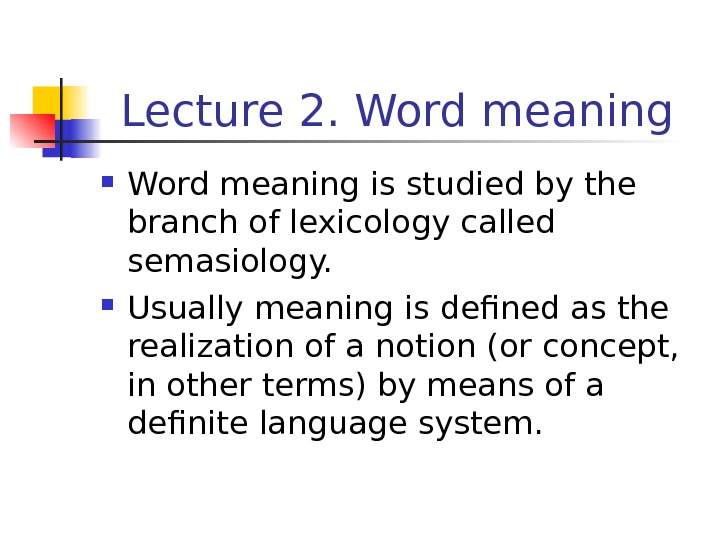
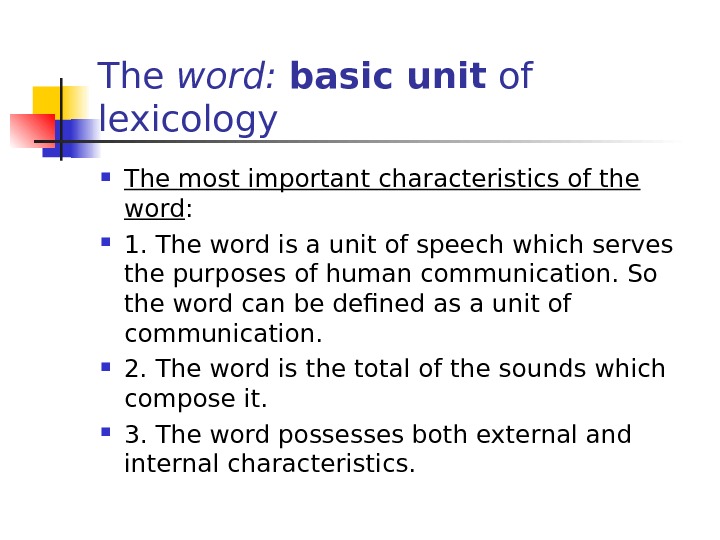
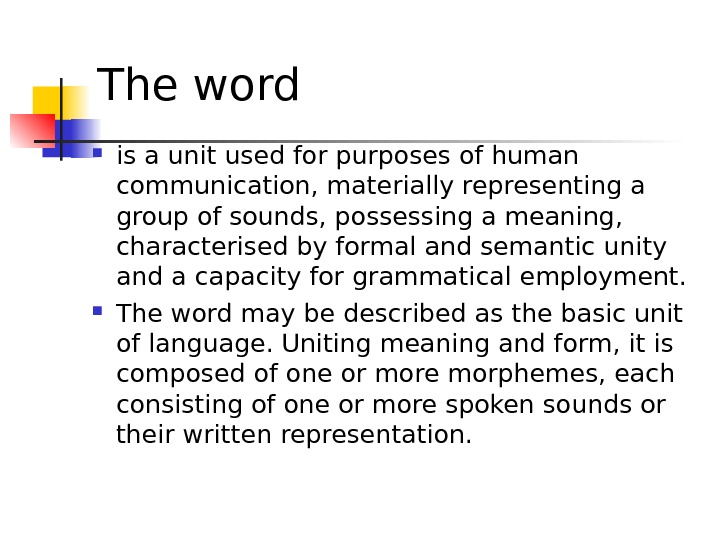
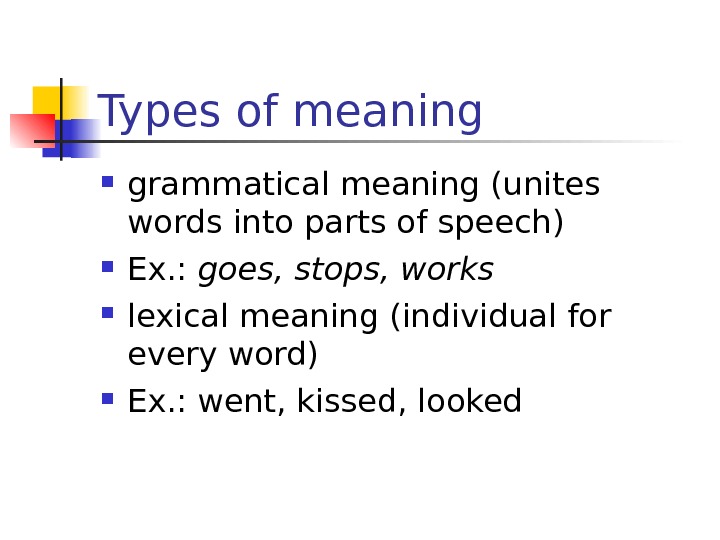
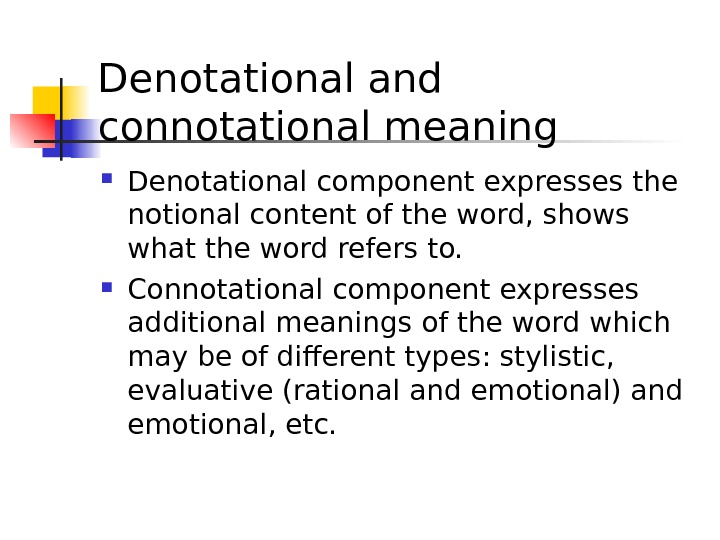


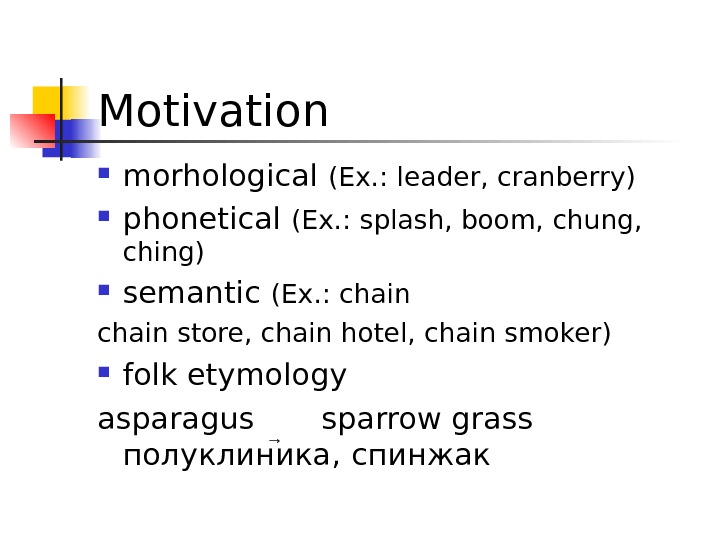

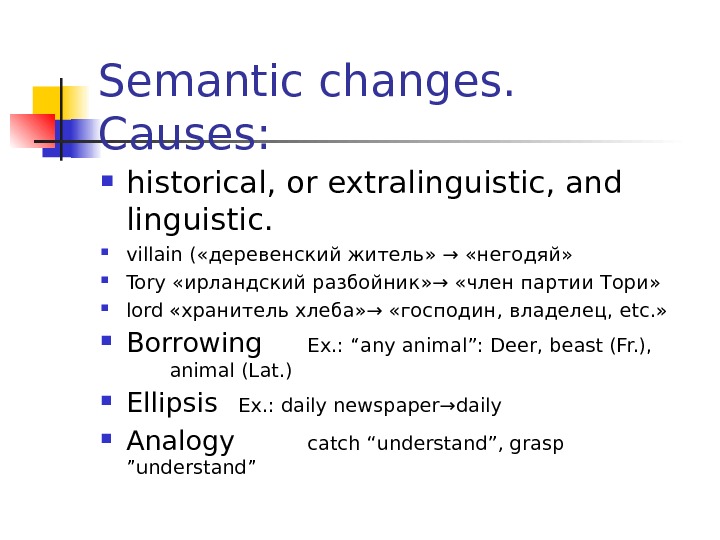
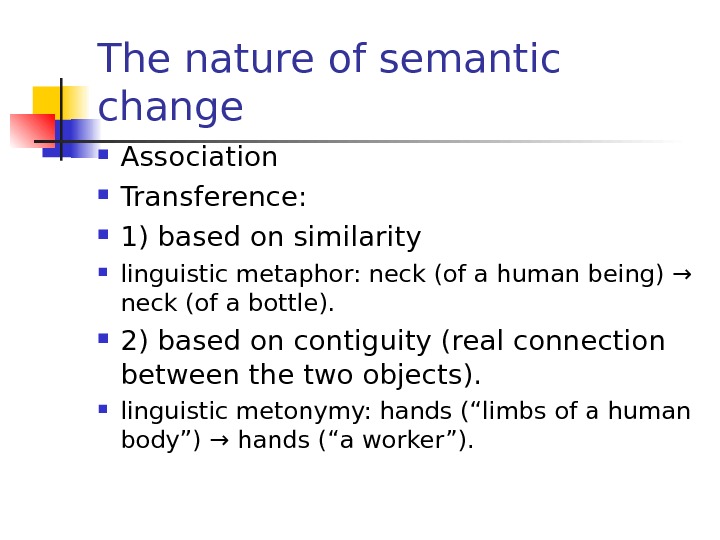
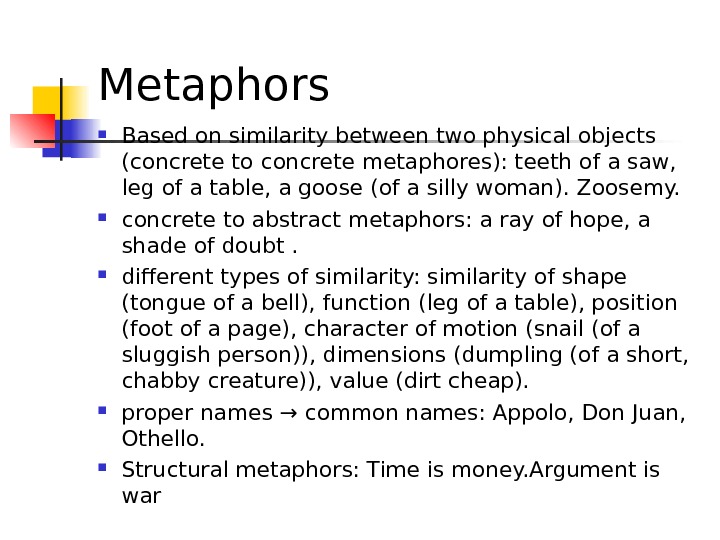



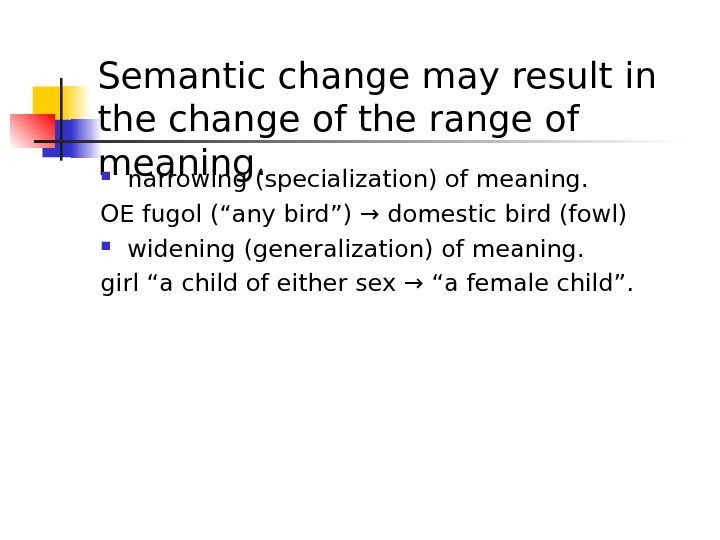
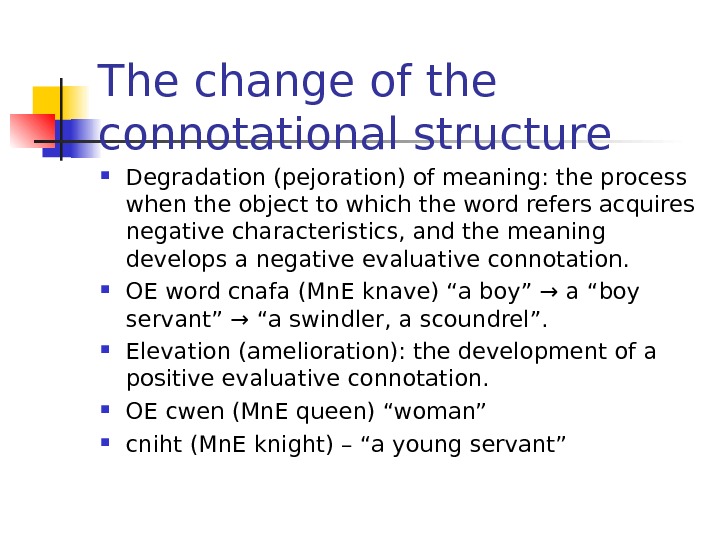
Chapter 7 what is «meaning»?
Language is the amber in which
a thousand precious and subtle
thoughts have been safely
embedded and preserved
(From Word and Phrase by J. Fitzgerald)
The question posed by the title of this chapter is one of those questions which are easier to ask than answer The linguistic science at present is not able to put forward a definition of meaning which is conclusive.
However, there are certain facts of which we can be reasonably sure, and one of them is that the very function of the word as a unit of communication is made possible by its possessing a meaning. Therefore, among the word’s various characteristics, meaning is certainly the most important.
Generally speaking, meaning can be more or less described as a component of the word through which a concept is communicated, in this way endowing the word with the ability of denoting real objects, qualities actions and abstract notions. The complex and somewhat mysterious relationships between referent (object, etc. denoted by the word), concept and word are traditionally represented by the following triangle [35]:
By the «symbol» here is meant the word; thought or reference is concept. The dotted line suggests that there is no immediate relation between word and referent: it is established only through the concept.
On the other hand, there is a hypothesis that concepts can only find their realization through words. It seems that thought is dormant till the word wakens it up. It is only when we hear a spoken word or read a printed word that the corresponding concept springs into mind.
The mechanism by which concepts (i. e. mental phenomena) are converted into words (i. e. linguistic phenomena) and the reverse process by which a heard or a printed word is converted into a kind of mental picture are not yet understood or described. Probably that is the reason why the process of communication through words, if one gives it some thought, seems nothing short of a miracle. Isn’t it fantastic that the mere vibrations of a speaker’s vocal chords should be taken up by a listener’s brain and converted into vivid pictures? If magic does exist in the world, then it is truly the magic of human speech; only we are so used to this miracle that we do not realize its almost supernatural qualities.
The branch of linguistics which specializes in the study of meaning is called semantics. As with many terms, the term «semantics» is ambiguous for it can stand, as well, for the expressive aspect of language in general and for the meaning of one particular word in all its varied aspects and nuances (i. e. the semantics of a word = the meaning(s) of a word).
As Marip Pei puts it in The Study of Language, «Semantics is ‘language’ in its broadest, most inclusive aspect. Sounds, words, grammatical forms, syntactical constructions are the tools of language. Semantics is language’s avowed purpose.» [39]
The meanings of all the utterances of a speech community are said by another leading linguist to include the total experience of that community; arts, science, practical occupations, amusements, personal and family life.
The modern approach to semantics is based on the assumption that the inner form of the word (i. e. its meaning) presents a structure which is called the semantic structure of the word.
Yet, before going deeper into this problem, it is necessary to make a brief survey of another semantic phenomenon which is closely connected with it.
Polysemy. Semantic Structure of the Word
The semantic structure of the word does not present an indissoluble unity (that is, actually, why it is referred to as «structure»), nor does it necessarily stand for one concept. It is generally known that most words convey several concepts and thus possess the corresponding number of meanings. A word having several meanings is called polysemantic, and the ability of words to have more than one meaning is described by the term polysemy.
Two somewhat naive but frequently asked questions may arise in connection with polysemy:
1. Is polysemy an anomaly or a general rule in English vocabulary?
2. Is polysemy an advantage or a disadvantage so far as the process of communication is concerned? Let us deal with both these questions together. Polysemy is certainly not an anomaly. Most English words are polysemantic. It should be noted that the wealth of expressive resources of a language largely depends on the degree to which polysemy has developed in the language. Sometimes people who are not very well informed in linguistic matters claim that a language is lacking in words if the need arises for the same word to be applied to several different phenomena. In actual fact, it is exactly the opposite: if each word is found to be capable of conveying, let us say, at least two concepts instead of one, the expressive potential of the whole vocabulary increases twofold. Hence, a well-developed polysemy is not a drawback but a great advantage in a language.
On the other hand, it should be pointed out that the number of sound combinations that human speech organs can produce is limited. Therefore at a certain stage of language development the production of new words by morphological means becomes limited, and polysemy becomes increasingly important in providing the means for enriching the vocabulary. From this, it should be clear that the process of enriching the vocabulary does not consist merely in adding new words to it, but, also, in the constant development of polysemy.
The system of meanings of any polysemantic word develops gradually, mostly over the centuries, as more and more new meanings are either added to old ones, or oust some of them (see Ch. 8). So the complicated processes of polysemy development involve both the appearance of new meanings and the loss of old ones. Yet, the general tendency with English vocabulary at the modern stage of its history is to increase the total number of its meanings and in this way to provide for a quantitative and qualitative growth of the language’s expressive resources.
When analysing the semantic structure of a polysemantic word, it is necessary to distinguish between two levels of analysis.
On the first level, the semantic structure of a word is treated as a system of meanings. For example, the semantic structure of the noun fire could be roughly presented by this scheme (only the most frequent meanings are given):
The above scheme suggests that meaning I holds a kind of dominance over the other meanings conveying the concept in the most general way whereas meanings П—V are associated with special circumstances, aspects and instances of the same phenomenon.
Meaning I (generally referred to as the main meaning) presents the centre of the semantic structure of the word holding it together. It is mainly through meaning I that meanings II—V (they are called secondary meanings) can be associated with one another, some of them exclusively through meaning I, as, for instance, meanings IV and V.
It would hardly be possible to establish any logical associations between some of the meanings of the noun bar except through the main meaning:1
Bar, n
II III
I
|
Any kind of barrier to prevent people from passing.
|
Meanings II and III have no logical links with one another whereas each separately is easily associated with meaning I: meaning II through the traditional barrier dividing a court-room into two parts; meaning III through the counter serving as a kind of barrier between the customers of a pub and the barman.
Yet, it is not in every polysemantic word that such a centre can be found. Some semantic structures are arranged on a different principle. In the following list of meanings of the adjective dull one can hardly hope to find a generalized meaning covering and holding together the rest of the semantic structure.
Dull, adj.
I. Uninteresting, monotonous, boring; e. g. a dull book, a dull film.
II. Slow in understanding, stupid; e. g. a dull student.
III. Not clear or bright; e. g. dull weather, a dull day, a dull colour.
IV. Not loud or distinct; e. g. a dull sound.
V. Not sharp; e. g. a dull knife.
VI. Not active; e. g. Trade is dull.
VII. Seeing badly; e. g. dull eyes (arch.). VIII. Hearing badly; e. g. dull ears (arch.).
Yet, one distinctly feels that there is something that all these seemingly miscellaneous meanings have in common, and that is the implication of deficiency, be it of colour (m. Ill), wits (m. II), interest (m. I), sharpness (m. V), etc. The implication of insufficient quality, of something lacking, can be clearly distinguished in each separate meaning.
In fact, each meaning definition in the given scheme can be subjected to a transformational operation to prove the point.
Dull, adj.
I. Uninteresting ——> deficient in interest or excitement.
II. … Stupid ——> deficient in intellect.
III. Not bright ——> deficient in light or colour.
IV. Not loud ——> deficient in sound.
V. Not sharp ——> deficient in sharpness.
VI. Not active ——> deficient in activity.
VII. Seeing badly ——> deficient in eyesight.
VIII. Hearing badly ——> deficient in hearing.
The transformed scheme of the semantic structure of dull clearly shows that the centre holding together the complex semantic structure of this word is not one of the meanings but a certain component that can be easily singled out within each separate meaning.
This brings us to the second level of analysis of the semantic structure of a word. The transformational operation with the meaning definitions of dull reveals something very significant: the semantic structure of the word is «divisible», as it were, not only at the level of different meanings but, also, at a deeper level.
Each separate meaning seems to be subject to structural analysis in which it may be represented as sets of semantic components. In terms of componential analysis, one of the modern methods of semantic research, the meaning of a word is defined as a set of elements of meaning which are not part of the vocabulary of the language itself, but rather theoretical elements, postulated in order to describe the semantic relations between the lexical elements of a given language.
The scheme of the semantic structure of dull shows that the semantic structure of a word is not a mere system of meanings, for each separate meaning is subject to further subdivision and possesses an inner structure of its own.
Therefore, the semantic structure of a word should be investigated at both these levels: a) of different meanings, b) of semantic components within each separate meaning. For a monosemantic word (i. e. a word with one meaning) the first level is naturally excluded.
Types of Semantic Components
The leading semantic component in the semantic structure of a word is usually termed denotative component (also, the term referential component may be used). The denotative component expresses the conceptual content of a word.
The following list presents denotative components of some English adjectives and verbs:
Denotative components
lonely, adj. ——> alone, without company ……………
notorious, adj. ——> widely known ……………
celebrated, adj. ——> widely known ……………
to glare, v. ——> to look ……………
to glance, v. ——> to look ……………
to shiver, v. ——> to tremble ……………
to shudder, v. ——> to tremble ……………
It is quite obvious that the definitions given in the right column only partially and incompletely describe the meanings of their corresponding words. To give a more or less full picture of the meaning of a word, it is necessary to include in the scheme of analysis additional semantic components which are termed connotations or connotative components.
Let us complete the semantic structures of the words given above introducing connotative components into the schemes of their semantic structures.
The above examples show how by singling out denotative and connotative components one can get a sufficiently clear picture of what the word really means. The schemes presenting the semantic structures of glare, shiver, shudder also show that a meaning can have two or more connotative components.
The given examples do not exhaust all the types of connotations but present only a few: emotive, evaluative connotations, and also connotations of duration and of cause. (For a more detailed classification of connotative components of a meaning, see Ch. 10.)
Meaning and Context
In the beginning of the paragraph entitled «Polysemy» we discussed the advantages and disadvantages of this linguistic phenomenon. One of the most important «drawbacks» of polysemantic words is that there is sometimes a chance of misunderstanding when a word is used in a certain meaning but accepted by a listener or reader in another. It is only natural that such cases provide stuff of which jokes are made, such as the ones that follow:
Customer. I would like a book, please.
Bookseller. Something light?
Customer. That doesn’t matter. I have my car with me.
In this conversation the customer is honestly misled by the polysemy of the adjective light taking it in the literal sense whereas the bookseller uses the word in its figurative meaning «not serious; entertaining».
In the following joke one of the speakers pretends to misunderstand his interlocutor basing his angry retort on the polysemy of the noun kick:
The critic started to leave in the middle of the second act of the play.
«Don’t go,» said the manager. «I promise there’s a terrific kick in the next act.»
«Fine,» was the retort, «give it to the author.»1
Generally speaking, it is common knowledge that context is a powerful preventative against any misunderstanding of meanings. For instance, the adjective dull, if used out of context, would mean different things to different people or nothing at all. It is only in combination with other words that it reveals its actual meaning: a dull pupil, a dull play, a dull razor-blade, dull weather, etc. Sometimes, however, such a minimum context fails to reveal the meaning of the word, and it may be correctly interpreted only through what Professor N. Amosova termed a second-degree context [1], as in the following example: The man was large, but his wife was even fatter. The word fatter here serves as a kind of indicator pointing that large describes a stout man and not a big one.
Current research in semantics is largely based on the assumption that one of the more promising methods of investigating the semantic structure of a word is by studying the word’s linear relationships with other words in typical contexts, i. e. its combinability or collocability.
Scholars have established that the semantics of words characterized by common occurrences (i. e. words which regularly appear in common contexts) are correlated and, therefore, one of the words within such a pair can be studied through the other.
Thus, if one intends to investigate the semantic structure of an adjective, one would best consider the adjective in its most typical syntactical patterns A + N (adjective + noun) and N + l + A (noun + link verb + adjective) and make a thorough study of the meanings of nouns with which the adjective is frequently used.
For instance, a study of typical contexts of the adjective bright in the first pattern will give us the following sets: a) bright colour (flower, dress, silk, etc.), b) bright metal (gold, jewels, armour, etc.), c) bright student (pupil, boy, fellow, etc.), d) bright face (smile, eyes, etc.) and some others. These sets will lead us to singling out the meanings of the adjective related to each set of combinations: a) intensive in colour, b) shining, c) capable, d) gay, etc.
For a transitive verb, on the other hand, the recommended pattern would be V + N (verb + direct object expressed by a noun). If, for instance, our object of investigation are the verbs to produce, to create, to compose, the correct procedure would be to consider the semantics of the nouns that are used in the pattern with each of these verbs: what is it that is produced? created? composed?
There is an interesting hypothesis that the semantics of words regularly used in common contexts (e. g. bright colours, to build a house, to create a work of art, etc.) are so intimately correlated that each of them casts, as it were, a kind of permanent reflection on the meaning of its neighbour. If the verb to compose is frequently used with the object music, isn’t it natural to expect that certain musical associations linger in the meaning of the verb to compose?
Note, also, how closely the negative evaluative connotation of the adjective notorious is linked with the negative connotation of the nouns with which it is regularly associated: a notorious criminal, thief, gangster, gambler, gossip, liar, miser, etc.
All this leads us to the conclusion that context is a good and reliable key to the meaning of the word. Yet, even the jokes given above show how misleading this key can prove in some cases. And here we are faced with two dangers. The first is that of sheer misunderstanding, when the speaker means one thing and the listener takes the word in its other meaning.
The second danger has nothing to do with the process of communication but with research work in the field of semantics. A common error with the inexperienced research worker is to see a different meaning in every new set of combinations. Here is a puzzling question to illustrate what we mean. Cf.: an angry man, an angry letter. Is the adjective angry used in the same meaning in both these contexts or in two different meanings? Some people will say «two» and argue that, on the one hand, the combinability is different (man — name of person; letter — name of object) and, on the other hand, a letter cannot experience anger. True, it cannot; but it can very well convey the anger of the person who wrote it. As to the combinability, the main point is that a word can realize the same meaning in different sets of combinability. For instance, in the pairs merry children, merry laughter, merry faces, merry songs the adjective merry conveys the same concept of high spirits whether they are directly experienced by the children (in the first phrase) or indirectly expressed through the merry faces, the laughter and the songs of the other word groups.
The task of distinguishing between the different meanings of a word and the different variations of combinability (or, in a traditional terminology, different usages of the word) is actually a question of singling out the different denotations within the semantic structure of the word.
Cf.: 1) a sad woman,
2) a sad voice,
3) a sac? story,
4) a sad scoundrel (= an incorrigible scoundrel)
5) a sad night (= a dark, black night, arch. poet.)
How many meanings of sad can you identify in these contexts? Obviously the first three contexts have the common denotation of sorrow whereas in the fourth and fifth contexts the denotations are different. So, in these five contexts we can identify three meanings of sad.
All this leads us to the conclusion that context is not the ultimate criterion for meaning and it should be used in combination with other criteria. Nowadays, different methods of componential analysis are widely used in semantic research: definitional analysis, transformational analysis, distributional analysis. Yet, contextual analysis remains one of the main investigative methods for determining the semantic structure of a word.
Exercises
I. Consider your answers to the following.
1. What is understood by «semantics»? Explain the term «polysemy».
2. Define polysemy as a linguistic phenomenon. Illustrate your answer with your own examples.
3. What are the two levels of analysis in investigating the semantic structure of a word?
4. What types of semantic components can be distinguished within the meaning of a word?
5. What is one of the most promising methods for investigating the semantic structure of a word? What is understood by collocability (combinability)?
6. How can one distinguish between the different meanings of a word and the different variations of combinability?
II. Define the meanings of the words in the following sentences. Say how the meanings of the same word are associated one with another.
1.I walked into Hyde Park, fell flat upon the grass and almost immediately fell asleep. 2. a) ‘Hello’, I said, and thrust my hand through the bars, whereon the dog became silent and licked me prodigiously, b) At the end of the long bar, leaning against the counter was a slim pale individual wearing a red bow-tie. 3. a) I began to search the flat, looking in drawers and boxes to see if I could find a key. b) I tumbled with a sort of splash upon the keys of a ghostly piano, c) Now the orchestra is playing yellow cocktail music and the opera of voices pitches a key higher, d) Someone with a positive manner, perhaps a detective, used the expression ‘madman’ as he bent over Welson’s body that afternoon, and the authority of his voice set the key for the newspaper report next morning. 4. a) Her mouth opened crookedly half an inch, and she shot a few words at one like pebbles. b) Would you like me to come to the mouth of the river with you? 5. a) I sat down for a few minutes with my head in ray hands, until I heard the phone taken up inside and the butler’s voice calling a taxi. b) The minute hand of the electric clock jumped on to figure twelve, and, simultaneously, the steeple of St. Mary’s whose vicar always kept his clock by the wireless began its feeble imitation of Big Ben. 6. a) My head felt as if it were on a string and someone were trying to pull it off. b) G. Quartermain, board chairman and chief executive of Supernational Corporation was a bull of a man who possessed more power than many heads of the state and exercised it like a king.
III. Copy out the following pairs of words grouping together the ones which represent the same meaning of each word. Explain the different meanings and the different usages, giving reasons for your answer. Use dictionaries if necessary.
smart, adj.
smart clothes, a smart answer, a smart house, a smart garden, a smart repartee, a smart officer, a smart blow, a smart punishment
stubborn, adj.
a stubborn child, a stubborn look, a stubborn horse, stubborn resistance, a stubborn fighting, a stubborn cough, stubborn depression
sound, adj.
sound lungs, a sound scholar, a sound tennis-player, sound views, sound advice, sound criticism, a sound ship, a sound whipping
roof, n.
edible roots, the root of the tooth, the root of the matter, the root of all evil, square root, cube root
perform, v.
to perform one’s duty, to perform an operation, to perform a dance, to perform a play
kick, v.
to kick the ball, to kick the dog, to kick off one’s slippers, to kick smb. downstairs
IV. The verb «to take» is highly polysemantic in Modern English. On which meanings of the verb are the following jokes based? Give your own examples to illustrate the other meanings of the word.
1. «Where have you been for the last four years?» «At college taking medicine.» «And did you finally get well?»
2. «Doctor, what should a woman take when she is run down?»
«The license number, madame, the license number.»
3.Proctor (exceedingly angry): So you confess that this unfortunate Freshman was carried to this frog pond and drenched. Now what part did you take in this disgraceful affair?
Sophomore (meekly): The right leg, sir.
V. Explain the basis for the following jokes. Use the dictionary when in doubt.
1. Caller: I wonder if I can see your mother, little boy. Is she engaged9
Willie: Engaged! She’s married.
2. Booking Clerk (at a small village station):
You’ll have to change twice before you get to York.
Villager (unused to travelling): Goodness me! And I’ve only brought the clothes I’m wearing.
3. The weather forecaster hadn’t been right in three months, and his resignation caused little surprise. His alibi, however, pleased the city council.
«I can’t stand this town any longer,» read his note. «The climate doesn’t agree with me.»
4.Professor: You missed my class yesterday, didn’t you?
Unsubdued student: Not in the least, sir, not in the least.
5. «Papa, what kind of a robber is a page?» «A what?»
«It says here that two pages held up the bride’s train.»
VI. Choose any polysemantic word that is well-known to you and illustrate its meanings with examples of your own. Prove that the meanings are related one to another.
VII. Read the following jokes. Analyse the collocability of the italicized words and state its relationship with the meaning.
1. Ladу (at party): Where is that pretty maid who was passing our cocktails a while ago?
Hostess: Oh, you are looking for a drink?
Lady: No, I’m looking for my husband.
2. Peggy: I want to help you, Dad. I shall get the dress-maker to teach me to cut out gowns.
Dad: I don’t want you to go that far. Peg, but you might cut out cigarettes, and taxi bills.
3. There are cynics who claim that movies would be better if they shot less films and more actors.
4. Killy: Is your wound sore, Mr. Pup?
Mr. Pup: Wound? What wound?
Kitty: Why, sister said she cut you at the dinner last night.
VIII. Try your hand at being a lexicographer. Write simple definitions to illustrate as many meanings as possible for the following polysemantic words. After you have done it, check your results using a dictionary.
Face, heart, nose, smart, to lose.
IX. Try your hand at the following research work.
a. Illustrate the semantic structure of one of the following words with a diagram; use the dictionary if necessary.
Foot, п.; hand, п.; ring, п.; stream, n.; warm, adj.; green, adj.; sail, n.; key, n.; glass, п.; eye, n.
b. Identify the denotative and connotative elements of the meanings in the following pairs of words.
To conceal — to disguise, to choose — to select, to draw — to paint, money — cash, photograph — picture, odd — queer.
c. Read the entries for the English word «court» and the Russian «суд» in an English-Russian and Russian-English dictionary. Explain the differences in the semantic structure of both words.
Автор: • Декабрь 21, 2017 • Лекция • 589 Слов (3 Страниц) • 1,912 Просмотры
Страница 1 из 3
Lecture (December, the 4th)
WORD MEANING
Introduction
There exist various theories of word meaning — in philosophy, linguistics, psychology, neuroscience and artificial intelligence, since research on word meaning is highly interdisciplinary. There have been too many attempts to define lexical meaning, we’ll consider the shortest one: lexica meaning is the realization of a concept (a fragment of knowledge) by means of a definite language system.
Why is it difficult to define lexical meaning?
- Every word combines lexical and grammatical meaning: books.
- The lexical meaning very often includes denotational and connotational meanings: skinny vs thin.
- The denotational meaning is not homogenous, it encompasses semantic components (semes): book -“a handwritten or printed work of fiction or nonfiction, usually onsheets of paper fastened or bound together within covers”.
- Most words are polysemantic (poly′semous).
Types of meaning
The grammatical meaning is more abstract and generalized. It characterizes all individual forms of different words: cats, books, children, etc. the grammatical meaning of plurality); asked, did, translated, etc. the grammatical meaning Past Simple.
The lexical meaning is concrete and individual. It characterizes all grammatical word-forms: cracks, cracked, cracking, has cracked, etc. – these grammatical forms have the same lexical meaning.
Aspects of meaning
The lexical meaning is characterized by three aspects – semantic, syntactic and pragmatic.
In the semantic aspect two sides are singled out – ′deno′tative and sig′nificative.
Deno′tatum involves all the objects of reality named by this word. Significant is the reflection of the properties of the denoted object in the human mind.
The pragmatic meaning encompasses different connotations.
Stylistic connotations (social connotations) refer to the social situation (social circumstances) characterizing communication: bog – toilet – restroom.
Emotional connotations in a word point to some emotion accompanying the denotative component: glare – to look in anger.
…
Доступно только на Essays.club










